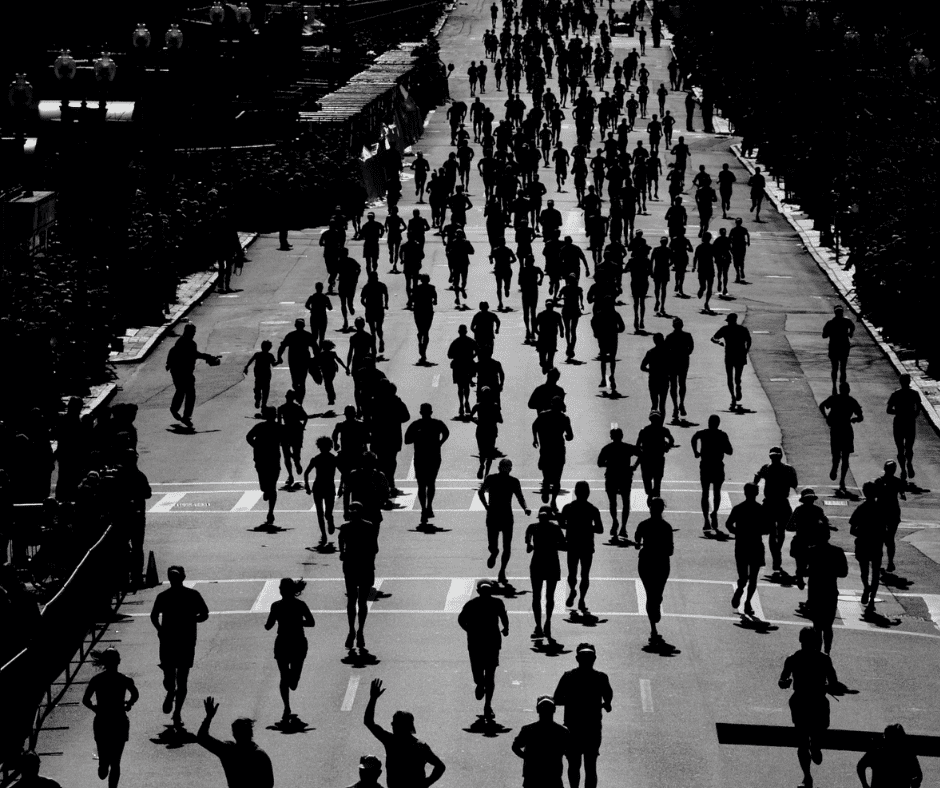Following a run/walk strategy in the London Marathon has many benefits, it can be effective and result in you completing the marathon in your time goal… when executed correctly.
Walking in the London Marathon is far from a sign of failure and giving up…
Runner and coach Jeff Galloway made the run-walk method or the “Jeff Galloway Method” popular in the 1970s.
The Run/walk method is a running strategy that involves incorporating planned walking breaks throughout your run.
In this article, we will cover…
- How To Implement a Run Walk Strategy In Your London Marathon Training
- Is It Ok To Run Walk The London Marathon?
- Effectiveness Of The Run Walk Method (Pros & Cons)
- London Marathon Run Walk Strategy
- Run Walk The London Marathon In Under 5 Hours
- Run Walk The London Marathon In Under 4 Hours
Let’s dive into the run-walk strategy…

How To Implement a Run-Walk Strategy In Your London Marathon Training
Here at Coach Parry, we are huge fans of the run-walk strategy.
The question is when and how you should start employing the run-walk strategy in your London Marathon plan…
You do not need to practice the run-walk method in every single training run you go on. The most appropriate place to practice it is on your long runs. This is so that you can get into a rhythm.
The important thing about a run-walk strategy isn’t how much running you do versus how much walking you do, it’s about settling on a routine you’re comfortable with and need to implement from the get-go.
The method would essentially be ranging from: running three minutes, walking one minute all the way up to out say about 10 kilometers. So running 10 km and walking for 1 minute.
The further back in the field you are, the more effective it becomes… if you do it more often. I would recommend something along the lines of 1 to 2 minutes of walking every 3 to 6 kilometers and then of course you need to also factor in a bit of extra walking on the hills.
Hills are the second component to walking…
For very steep or very long hills I recommend sticking to 1 minute of running and 1 minute of walking… Or running 2 poles, walking 1 pole… It just needs to be something you are comfortable with but it needs to feel like you have run far enough that you deserve a walk.
The whole point of those walks is that it’s supposed to keep you feeling fresh and your legs feeling good as long as possible so that your average speed over the long term improves.
The earlier in your training cycle you’ve started practicing this method, the more comfortable you’re going to get with it and it’s going to be easier to do at the London Marathon.
With regard to different terrains, you need to be flexible, you need to be able to play it by ear. For example, when you get to a hill, but you’ve just had your walk break so now you assume you need to run the entire hill… It’s not going to work.
You need to break that hill up and take some extra walk breaks.
The flip side is also true with downhills…
You probably think to yourself that you don’t want to waste walk breaks down hills. The truth is that you must not be stubborn about that, to break the downhill up with a walk break is going to do wonders for your muscles and you won’t get to the bottom of the hill with tired legs.
The most important thing is to always try and have a short walk before you absolutely need it.
Now that we know how to implement the run-walk strategy into our training, let’s see why it’s okay to implement it on race day…
Is It Ok To Run Walk The London Marathon?
The London Marathon does NOT disqualify participants for walking. In fact, it’s quite common to see runners following a run-walk strategy.

The London Marathon cut-off time is 7 hours which means if you were to walk the entire route you could take anywhere between 6 to 9 hours… depending on your pace.
Support is provided for those marathoners who choose to walk the 26.2 miles, which means it’s more than alright to follow a run/walk method as you will have plenty of time left over and the cut-off time won’t even be something to worry about.
We know it’s possible, but how effective is the run-walk method on The London Marathon race day?
Effectiveness Of The Run Walk Method (Pros & Cons)
Pros of the run-walk method during the London Marathon:
- If you’re new to running then implementing a run/walk strategy will make you feel more in control of your race strategy and pacing strategy.
- Walking breaks are basically quick boosts of active recovery which help you feel less fatigued, help you conserve energy, and allow your muscles to recover.
- Walk breaks help prevent running injuries as they reduce the effect of repetitive stress on your joints that comes from running.
- Counter-intuitive we know, but including talk sessions into your race strategy may help you achieve a faster marathon time. This is because walking helps you feel less fatigued and will leave you with sufficient energy reserves for the second half of the marathon to finish strong.
- Following a run/walk strategy during the London Marathon will keep you focused and keep your mind on the strategy rather than on the million other things happening around you.
Cons of the run-walk method during the London Marathon:
- The only real negative some runners might point out in the run-walk method is that on race day… when you are surrounded by all the other runners, the supporters are shouting for you and the buzz is extremely motivating…and you’re “feeling it”, it’s a bit of a challenge to walk when you have planned to.
As you can see, there are way more positives than negatives when it comes to implementing the run-walk strategy during the London Marathon… So, let’s have a look at how to implement the strategy on race day.
London Marathon Run Walk Strategy

Keeping in mind the 7-hour cut-off time, you do need to be strategic with this method.
You’ll need to find a ratio of running to walking for this method to work for you in the London Marathon.
The best ratio depends on the individual runner and their London Marathon race time goal.
If your goal is to simply finish the London marathon using this method you have a lot of options.
For example, to run a 10-minute mile you could train by running for 90 seconds and walking for 30 seconds.
Then you repeat this throughout the race.
You can also choose your run-walk ratio based on a mileage number… You could run for 1 mile and walk for 30 seconds.
We’ve put together the ultimate beginners’ London Marathon Training plan that might be of interest to you: Ensure your success with the Coach Parry Couch to London Marathon Training Roadmap.
But, if you have a specific time goal in mind then…
Run Walk The London Marathon In Under 3:30 hours, 4 hours, and 5 Hours
Jeff Galloway advises runners aiming for a 3:30 London marathon to run 4 minutes, and walk 30 seconds.
You could also run for 2 minutes and walk for 15 seconds.
For those runners wanting to achieve between a 5-hour and 6-hour London Marathon finish, they should run for 30 seconds and then walk for 30 seconds.

Or you could run for 15 seconds and walk for 15 seconds.
It’s important to remember that running uses different muscles than walking does, so even if you can easily run a marathon distance, following the run-walk method is an entirely different story and that’s why you must practice this method in your training and your long runs.



Comments are closed.